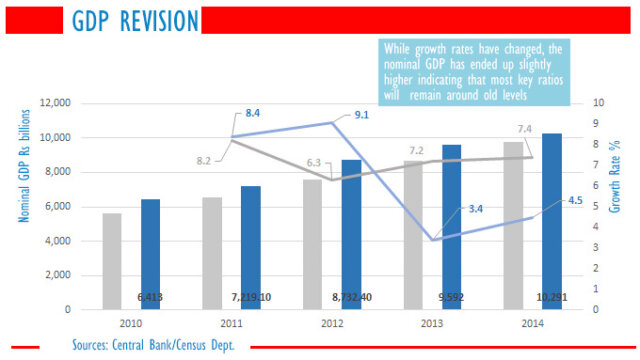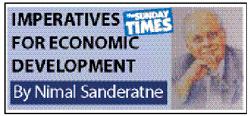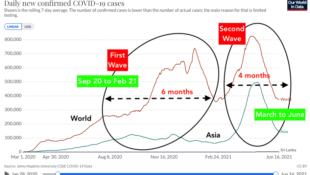
Will the Sri Lankan economy be Asia’s left behind economy? Learning from Vietnam
- By Quibit
- 5042 views
Despite uncertainty in the global economy, Asia is expected to be the fastest growing region in the world. In fact Asia’s dynamic economies are continuing to lead global economic growth. Asian economic growth is likely to be around 6 percent this year.
Sri Lanka’s economic growth is expected to dip to about 4.5 percent this year and will be one of the slowest growing economies in Asia. It is certainly not one of Asia’s dynamic economies. There are lessons to be learnt from the recent development experience of Asian economies, particularly the pragmatic economic policies pursued by erstwhile communist Vietnam. Her readiness to undertake fundamental economic reforms are an example to be followed.

South Asia
South Asia that was for many decades a region of slow growth has emerged as a fast growing region. India’s growth is expected to reach 7.2 percent this year. Myanmar is expected to grow by 7.4 percent while Bangladesh is expected to grow at 6.8 percent.
Bangladesh that has generally been characterised as a slow growing economy has shown a dynamism recently. For about a decade, Bangladesh’s economy grew by about 6 percent and then posted a GDP growth of 7.1 percent in the 2015-16. The World Bank has projected 6.8 percent GDP growth for Bangladesh, despite internal security challenges and sluggish global demand.
Dynamic growth
Even more significant than these growth rates is the recognition of these South Asian countries as dynamic economies. For example Sri Lankan firms have located their enterprises in Bangladesh and Indonesia owing to her attractive investment climate.
China
Although there has been a setback to China’s rapid growth, the Chinese economy is expected to grow at above 6 percent, somewhat lower than India’s over 7 percent. Economic growth is expected to accelerate in most Southeast Asian economies owing to robust domestic demand that is now an important driver of growth in these countries. The East Asian and Pacific region is expected to grow at 6.2 percent this year. Indonesia is expected to grow at 5.2 percent and Malaysia at 4.5 percent. Thailand’s growth is expected to be somewhat more modest at 3.3 percent.
Vietnam
Among the dynamic economies of Asia is Vietnam. The foundation for Vietnam’s remarkable rapid economic growth over the past 30 years was laid by the economic and political reforms in 1986. These transformed the centrally planned communist country into a market economy that was outward looking. It recognised that her communist economic policies were dragging the economy down and adopted economic reforms that transformed the country into a competitive outward looking economy. This change spurred rapid economic growth and development and transformed Vietnam from one of the world’s poorest nations to a lower middle-income country.
Since 1990, Vietnam’s GDP per capita growth has been among the fastest in the world, averaging 6.4 percent a year in the 2000s. Poverty was reduced significantly and social indicators improved significantly. In 2016 Vietnam’s grew by 6 percent.
A foremost driver of Vietnam’s growth has been her export-oriented manufacturing. Foreign direct investment flows are increasing, new manufactures are being established and her export competitiveness is improving. It has attracted vast amounts of foreign direct investment, is connected with global value added chains, and is a top destination for tourists. Her economic policies are not hampered by political factors. Consequently Vietnam has been a fast growing economy.
Inefficient economic policies
The Sri Lankan economy is in stark contrast to that of Vietnam. It is hampered by obsolete and inefficient economic policies, a political coalition that does not allow for clear and pragmatic economic policies and much needed economic reforms for rapid economic growth.
In contrast to Vietnam Sri Lanka is having a trend of lower foreign investment, slow growth in manufacturing, declining exports, a large trade deficit, balance of payments difficulties and low foreign exchange reserves. It is compelled to borrow from foreign sources to repay foreign debt obligations.
Lack of consistent predictable policies
One of the fundamental reasons for the lack of dynamism in the economy is the lack of a committed consistent and predictable economic policy and programme that we discussed in last Sunday’s column. A dynamic economy could only be built by having a certain consistent and committed economic programme. The lack of such an agreed economic programme has been the foremost reason for the government’s inability to achieve rapid economic growth.
Despite the urgent need to adopt and implement such an agreed pragmatic economic programme, there does not appear to be a likelihood of the coalition government ironing out their differences and announcing a pragmatic economic programme. This is in stark contrast to the situation in Vietnam, Bangladesh or all other Asian countries that are growing at a fast pace. The government must adopt reforms that improve the investment climate, attracts foreign direct investment and improves the ease of doing business.
Lessons
Well-targeted structural reforms are essential to strengthen Sri Lanka’s resilience to external shocks and sustain strong and inclusive long-term growth. Economic reforms and certainty in economic policies could attract foreign direct investment and expand the economy’s capacity to absorb new technology. Foreign investment in export manufacturing is essential to boost the country’s exports. A prerequisite to such an impetus is the commitment to outward looking and free market policies.
Like Vietnam Sri Lanka must eschew her outmoded and impractical inward looking statist policies and undertake productivity-enhancing reforms and flexible labour legislation that attracts foreign investors. The country’s political culture, the coalition government and the pandering to the demands of multitude are hardly conducive to undertake the required economic reforms. This could well mean that the country would be the one left behind among Asia’s dynamic economies.
The 2016 Annual Report of the Central Bank highlighted the serious structural weaknesses in the economy and urged the government to implement reforms speedily:
“The performance of the Sri Lankan economy in 2016 reconfirmed the necessity of addressing the deep rooted structural issues, in order to enable the country to progress towards a higher growth trajectory”.
Furthermore, “it is essential that such policies are implemented swiftly with consistency in order to improve productivity and efficiency of the economy and to attract much needed foreign direct investments (FDIs) and boost investments from the domestic private sector, while seamlessly integrating with the global production networks.”




